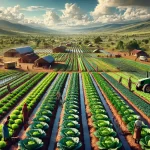Introduction
The agricultural sector in Kenya remains a cornerstone of our economy, contributing around 20% of the national GDP and employing over 40% of the total population—with more than 70% of the rural populace depending on it for their livelihoods. Despite its critical role, recent years have seen the sector face a myriad of challenges, ranging from erratic weather patterns to fluctuating global market conditions. However, within these challenges lie numerous opportunities, especially for investors looking to tap into the sector’s potential.
“The agricultural sector in Kenya remains a cornerstone of our economy, contributing around 20% of the national GDP and employing over 40% of the total population—with more than 70% of the rural populace depending on it for their livelihoods.”
This blog will take an in-depth look at the key challenges confronting the agricultural sector, the vast opportunities it offers, and the diverse investment options available. Additionally, we’ll examine the current state of agriculture in Kenya, emerging trends shaping its future, and why agriculture remains a compelling investment opportunity for both local and international players.
Key Challenges
1. High Cost of Farm Inputs
Over the recent past, farm inputs like seeds, fertilizers, and pesticides have become very expensive. This is mainly because of disrupted global supply chains, inflationary tendencies, and the devaluation of the Kenyan Shilling that raises the price of imported inputs. For the small-scale farmers who are the majority in the agricultural sector, this high input cost erodes their usually thin profit margins. This means that many farmers are not able to buy adequate quality inputs, hence resulting in lower yields, thereby reducing the general sector’s productivity.
2. Climate Change and Weather Variability
Unpredictable climatic conditions, that range from prolonged drought to erratic patterns of rainfall and rising temperatures, are linked to climate change. This pattern affects rain-fed agriculture throughout the country, thereby reducing productivity. Crops that rely on seasonal rains, most especially, suffer at the mercy of such unpredictability in rainfall. Drought conditions could lead to crop failures and eventually lead to food shortages, while erratic rainfall patterns can, on the other hand, bring about waterlogged fields damaging crops. This leads to increasing risk for farmers, low food security, and stress in the agricultural value chain.
3. Limited Access to Credit and Financial Services
Smallholders, in particular, have limited access to affordable credit and financial services. Due to the fact that agriculture is perceived as high-risk, vulnerable to weather and market fluctuations among other factors, financial institutions charge high interest rates or collateral that farmers are normally unable to obtain. Farmers cannot invest in modern farming machinery, improve the quality of inputs, or expand their operations since their business does not make it possible for them to access credit facilities. Without investment, productivity and profitability will be shallow.
4. Lack of Infrastructure
Agriculture in Kenya faces poor infrastructure in the form of inadequate roads and storage facilities, coupled with a limitation in access to electricity and water to drive irrigation. Poor roads make access and transportation of produce from farms to market points a difficult task; this leads to post-harvest losses and increasing costs of transport. Lack of storage facilities on the other hand contributes to increased spoilage, particularly for perishable goods, and limits access to irrigation facilities, contributing to reduced productivity during dry periods.
5. Fragmentation and Ownership Issues Around the Land
Inheritance practices in Kenya often result in land fragmentation into small and usually non-contiguous pieces of land, inhibiting economies of scale and often making mechanization difficult. Cloudy land ownership titles also impede farmers’ access to credit. Unclear landholdings reduce efficiency in farming operations and application of improved farming techniques. Unclear ownership of land makes land ownership uncertain and investment in long-term improvements like soil conservation or irrigation unviable.
6. Post-Harvest Losses
Post-harvest losses in the agricultural sector of Kenya are still high, especially among perishable commodities like fruits, vegetables, and dairy products. This is due to poor storage facilities, inadequate transport systems, and imbalance in processing opportunities. Losses during storage reduce farmers’ incomes from their produce and add to food insecurity. Due to lack of proper storage or transportation facilities, sometimes farmers have to sell their produce for lesser prices.
7. Pests and Diseases
Pests such as locusts and diseases like maize lethal necrosis have been frequent disasters to the country. This menace can wipe out a whole field within days, causing severe losses to farmers and food shortages. These are drawbacks to crop productivity because of increasing attacks of pests and diseases, apart from farm input costs that make farming expensive.
8. Market Access and Value Chains
Most of the small-scale farmers do not have access to either local or lucrative international markets; they lack networks and knowledge of how to enter value chains that could give them higher prices for their produce. Poor market access confines farmers’ bargaining power to mere selling at lower prices to middlemen. Farmers miss opportunities aimed at increasing their income through processing and value addition when they are not integrated into the value chain.
Opportunities
The following opportunities illustrate a great deal of potential that exists in the agricultural sector of Kenya. Addressing these opportunities with appropriate policies, investments, and partnerships will realize the full growth of the sector in contribution to the greater economic development of Kenya.
1. Expansion of Acreage
Farmers have been very optimistic about increasing the acreage for various crops, mainly vegetables such as kale, cabbages, and spinach. This optimism is based on the favorable prevailing weather conditions that provide a good environment for increasing production. By investing correctly, such an expansion of land use for these crops could significantly raise agricultural output. Increasing acreage means larger yields, heightened food security, and more export income opportunities, hence contributing to the gross domestic product. It also opens the way for mechanization, large-scale use of modern agricultural practices which increases efficiency and makes farming more productive.
2. Government Initiatives
The government has continued to support this sector through subsidized fertilizers and the possibility of introducing seed and pesticide subsidies. These are intended to reduce the cost burden on farmers, stimulating higher production and quality of the produce. Subsidized inputs reduce the overall cost of farming and make farming more accessible to the smallholder farmer. This would lead to better yields, improved profitability, and more stable food supplies, positively affecting both local consumption and export potential.
3. Irrigation
The report highlights the increased focus on irrigation as a productivity enhancement mechanism, especially in areas receiving high rainfall. Upscaling irrigation infrastructure should gradually reduce dependence on rain-fed farming and improve resilience to climate variability. Irrigation allows for more uniform crop production, even during dry seasons. This also facilitates diversification into a wider crop selection with extended growing seasons, leading to higher agricultural output and food security.
4. Market Equilibrium
These are the government interventions that might ensure price stabilization in markets, such as increasing the budget to the National Cereals and Produce Board. The NCPB cushions farmers from losses occasioned either by fluctuating prices from overproduction or disruption in the value chains of their crops. Stability in the markets, through government intervention, gives farmers an assured outlet for their produce. This means that at every instance of surplus or no surplus, farmers will earn decent prices for their products to retain levels of household income. It will further help in improving the levels of food security as consumers would not face price volatility.
5. Mechanization of Agriculture
The demand for mechanization is high, especially in land preparation. More access to subsidized farm equipment and tractors for hire will improve productivity significantly by reducing labor costs. Mechanization improves efficiency in farm operations such as planting, harvesting, and land preparation, hence speeding up the operations, improving yields, and cutting post-harvest losses. It also opens up farming to the youth and investors who might be interested in modern farming methods.
6. Extension Services
This tenet improves agriculture productivity through better access to extension services, such as agronomy advice and cropping management training. Such guidance by extension officers helps farmers change to better practices for improved yields. Extension services support farmers in acquiring best farming practices, pest management, and climate-resilient crops that enhance the quality of the produce, reduce post-harvest losses, and generally enhance the productivity of the sector.
Investment Outlook
Agriculture still plays a serious role in the development of Kenya’s economy; hence, the formidable opportunities it offers to both local and international investors. Although challenges exist, most of the opportunities in this sector are driven by emerging trends, which help in creating a conducive investment environment. Given below are key areas of investment in agriculture, and reasons for their attractiveness:
Expansion of Commercial Farming
Investors can, therefore, take advantage of the good prospects in land-use expansion, especially for vegetable production such as kale, cabbage, and spinach. Large-scale farming projects hold great promise given the increasing demand at the local and regional levels for fresh produce.
- Why It’s Appealing:
Growing demand both in the local and regional markets such as the EAC. The favorable climatic conditions and supportive government policy, like subsidies on fertilizers and pesticides. Organic and Niche Farming is a healthy alternative to conventional farming since no chemicals are used, and it caters to the preference of the global market. - Investment Opportunities:
Large-scale vegetable cultivation for export markets. This includes greenhouse farming or other such technologies, allowing for the extension of the growing season.
Irrigation and Infrastructure Development
This, in turn, has opened up more avenues for investment in the development of infrastructure in agribusiness through an expansion drive for irrigation, especially in arid and semi-arid areas. Irrigation technology can change underutilized land to fertile farmland.
- Why It’s Appealing:
Relies less on rain-fed agriculture and increases productivity even in dry seasons. Development in irrigation infrastructure is also being propelled by the system of government incentives and partnerships between its public-private sectors. Expands farming into new areas and increases food security. - Investment Opportunities:
Companies specializing in irrigation technologies dealing with drip, pivot, and sprinkler systems. Water conservation and harvesting systems suited to smallholder farmers. Projects dealing with the construction of dams and agricultural water distribution systems.
Mechanization and Agri-tech
Mechanization and technologies are fast changing the face of Kenya’s agricultural sector. On the side of investment, one may grab an opportunity in offering technology solutions to increase productivity, efficiency, and sustainability.
- Why It’s Appealing:
Accordingly, the government has been advocating for mechanization through subsidization of equipment and tractors. Interest in smart farming tools has been on the rise, the capability of mobile apps ranges from agronomy, weather forecasting to farm management. It enhances yields, reduces labor costs, and increases efficiency in farms. - Investment Opportunities:
Agri-tech startups offer a bouquet of digital solution services for farmers. The mechanized services include tractor renting and leasing of equipment. Partnership with local governments in the distribution of subsidized farm equipment.
Agricultural Processing and Value Addition
Kenya’s agricultural sector has traditionally focused on raw produce exports, but the potential for value addition through processing offers a new investment frontier. Processing agricultural products locally can increase profit margins and create jobs while reducing post-harvest losses.
- Why It’s Attractive:
The government is promoting value addition to increase the sector’s profitability. Potential tax incentives for setting up agro-processing plants. Growing middle-class demand for processed, ready-to-eat foods. Export opportunities for processed goods, especially in horticulture (e.g., dried fruits, packaged vegetables). - Investment Opportunities:
Setting up processing plants for tea, coffee, and horticultural products. Investing in cold storage facilities to reduce post-harvest losses. Export-oriented food processing for regional and international markets.
Sustainable and Climate-Resilient Farming
With climate change posing a significant challenge to agriculture, there is a growing need for investments in sustainable and climate-resilient farming practices. This includes organic farming, soil conservation, and agroforestry.
- Why It’s Attractive:
International markets are increasingly rewarding sustainable agricultural practices. Investment in climate-smart agriculture aligns with global ESG (Environmental, Social, and Governance) investment trends. The need to protect ecosystems while maintaining productivity creates opportunities for innovation in farming techniques. - Investment Opportunities:
Organic farming and certification for export to European markets. Agroforestry projects and sustainable land use initiatives. Investment in seed companies focusing on climate-resilient crop varieties.
Government-Led Agricultural Zones and Incentives
The Kenyan government continues to provide incentives for agriculture through various programs, including the establishment of special agricultural zones. Investors can tap into these incentives, which include tax holidays, subsidies, and other forms of government support aimed at boosting agricultural productivity.
- Why It’s Attractive:
Government-backed special agricultural zones lower the cost of entry for investors. Focus on export crops and value-added industries within these zones. Opportunities to collaborate with the government in public-private partnerships. - Investment Opportunities:
Large-scale farming in special agricultural zones. Collaboration with the government for research and development in modern farming techniques. Agricultural consulting services to help new investors navigate these government programs.
Conclusion
Kenya’s agricultural sector, while facing significant challenges, presents immense opportunities for growth and investment. By addressing key issues such as climate change, access to markets, and mechanization, the sector can significantly improve its productivity. For investors, this presents a promising opportunity to not only drive profit but also contribute to the development of a vital sector that is crucial to Kenya’s economic future.






